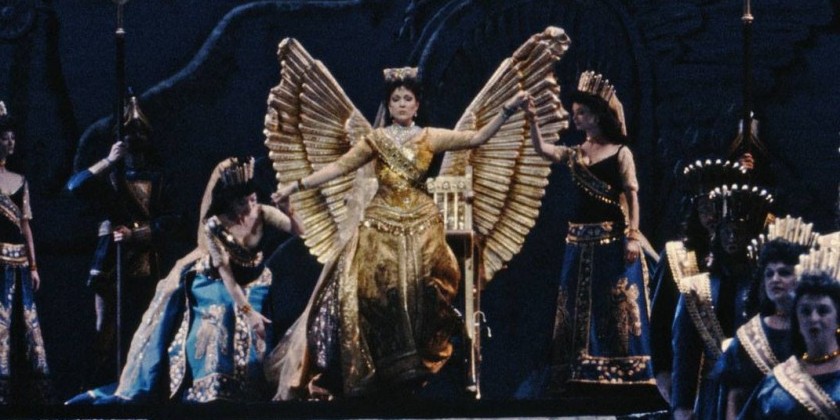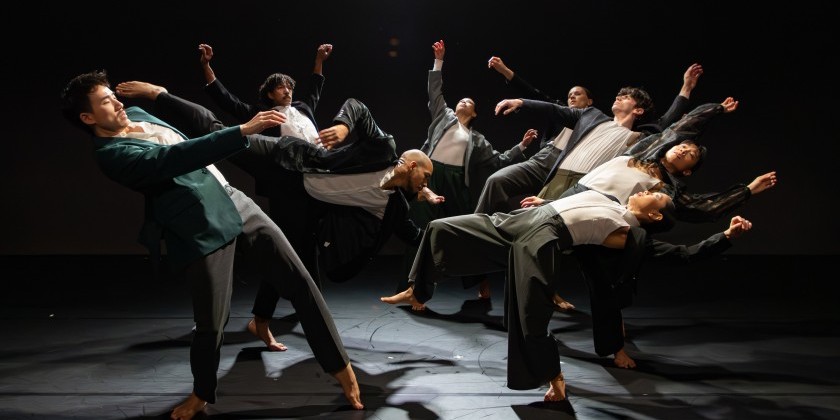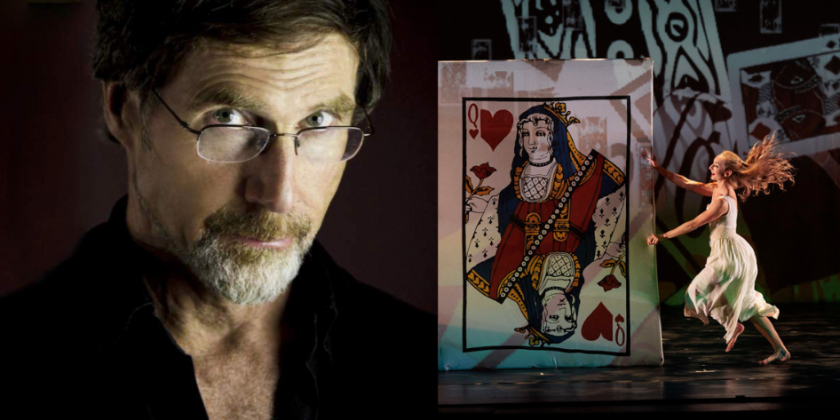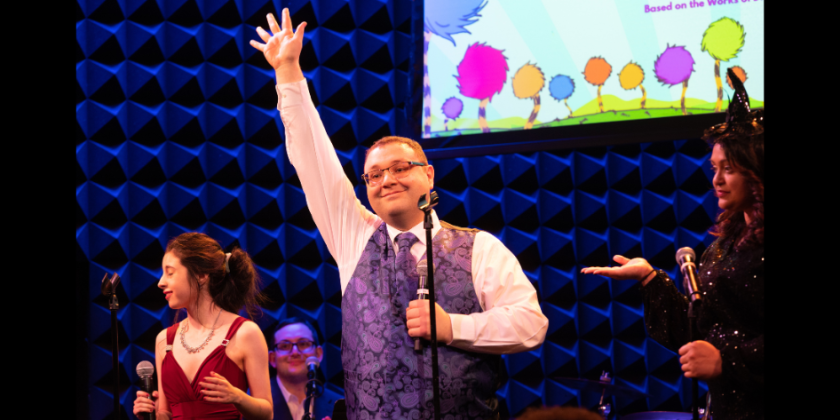IMPRESSIONS: NOEMIE LAFRANCE's "Choreography for Audiences: Take One"
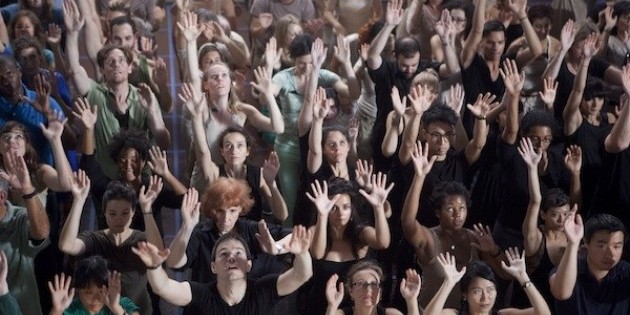
IMPRESSIONS: NOMIE LAFRANCE
Choreography for Audiences: Take One
Part of Brooklyn’s inaugural BEAT Festival, a performing arts initiative designed to celebrate Brooklyn’s diverse artistic community.
Presented in collaboration with the Irondale Center, a historic new performing arts space in Fort Greene.
Premier September 15th 2012
October 1st 2012
_________________________________________________________________
Theodora Boguszewski for The Dance Enthusiast
Recently dance makers have been struggling with various ways to engage audiences, the question being, “how can we change the way that audiences experience dance?” The ever-popular Sleep No More is a great example of how dance audiences are being challenged to explore an immersive dance environment.
It seems obvious that audiences want to participate. People love to go out dancing on the weekends, community dance classes are packed, and flash mobs have become a widespread part of our culture. How do choreographers close the gap between formal dance performances and social dance? Nomie Lafrance explores this in her newest work Choreography For Audience: Take One.
This premiere is an outgrowth of Agora (2005) and Agora 2 (2006), both interactive pieces staged at the then-closed McCarren Park Pool in Williamsburg, Brooklyn. In these works Lafrance started to explore ideas of including the audience in the performance. Unlike the previous works, Choreography for Audiences: Take One is the first piece that has ever made use of audience members as the sole performers. The September 15thevent was the first iteration of an ongoing large-scale project. There are more to come.
Last few minutes of Agora 2:
Phil Kester on the marimba. Bora Yoon vocals and violin. Filmed by Fred Hatt.
Choreography for Audiences: Take One is a live film and choreographic social experiment in which almost 300 people participate in a series of human games inspired by mathematic systems (think of the games you used to play on the lawn at summer camp, but much more intricate). Our participation in these games generates evolving patterns and formations, similar to a human kaleidoscope, which are captured on film. The succession of the games and ultimately the formations created are based not only on the specific game rules, but also on the individual choices of participants and the intuitive movement of the crowd as a whole. This particular installment included 12 different games, played in a random order.
I had a chance to speak with Lafrance after the show and she explained she had a deep interest in exploring the poles of cooperation and competition. She is also curious about how our world of technology has created a human need to reconnect to people in real time and space.
One of the first things that surprised me about the project was the level of participation that it required. When I got my email confirming my participation in the event, the first thing I had to do was to validate my ticket, which required that I read the instructions of the games we were to play. "No big deal," I thought, "I'll just skim through it, and I should be able to figure out the rules fairly easily." Two hours later, I found myself still trying to puzzle through all the instructions. Upon realizing the level of commitment required to participate, I was a bit skeptical. This project was putting a lot of faith in the participants. Who would have time to learn all these rules?
I had a chance to speak with Lafrance after the show and she explained she had a deep interest in exploring the poles of cooperation and competition. She is also curious about how our world of technology has created a human need to reconnect to people in real time and space.
.jpg) |
| Photo Poppy de Villeneuve 2012-Choreography For Audience: Take One by Noemie Lafrance a Sens Production |
One of the first things that surprised me about the project was the level of participation that it required. When I got my email confirming my participation in the event, the first thing I had to do was to validate my ticket, which required that I read the instructions of the games we were to play. "No big deal," I thought, "I'll just skim through it, and I should be able to figure out the rules fairly easily." Two hours later, I found myself still trying to puzzle through all the instructions. Upon realizing the level of commitment required to participate, I was a bit skeptical. This project was putting a lot of faith in the participants. Who would have time to learn all these rules?
When I arrived at the Irondale on Saturday afternoon, I was totally floored by the number of people who there, enthusiastic and prepared to play. Almost 300 people were brave enough not only to learn the rules, but also to show up and trust that everyone else had done the same. Almost 300 people were interested enough to put in the time and see what happened. My faith in the arts community was immediately boosted a few notches.
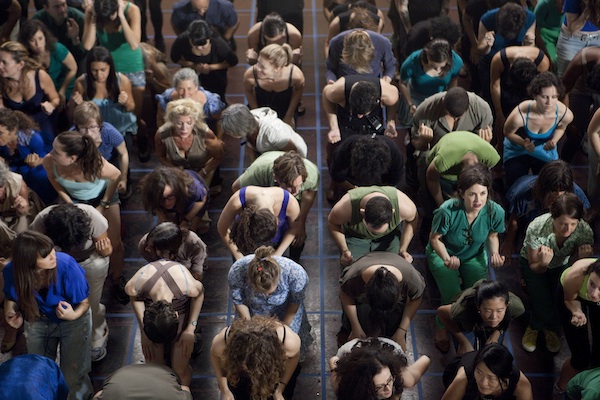 |
|
Photo Poppy de Villeneuve 2012 - Choreography For Audience: Take One by Noemie La France a Sens Production |
The audience consisted of a vast demographic, ranging from pre-teens to senior citizens. While it appeared that the dance community was well represented, it wasn’t obvious that the majority of performers were dancers. The participants were divided into four teams, blue, green, beige, and black. The team assignments were included in the confirmation email, which directed participants to the game instructions. Within the teams there were various layers of leadership- each team had three captains and up to twenty team leaders, all of whom had attended additional training sessions on the rules of the games. Beyond the captains and team leaders, there was a television screen overhead that told us what game we were playing.
Something about the experience felt like being inside of a science fiction novel - it was as if the project was a simulation of a society, and each game represented a different societal “rule” or standard. Being in a room full of strangers, our interactions dictated by a series of unspoken rules and guided by a Big-Brother-like television screen was quite surreal. On a more biological level, the project could also be seen as a simulation of an ecosystem - through our interactions with one another, we were able to generate complex patterns similar to the patterns found in nature.
-1.jpg) |
| Photo Poppy de Villeneuve 2012-Choreography For Audience: Take One by Noemie Lafrance a Sens Production |
Given the sheer number of us and the complexity of the games, my first thought was that this was sure to erupt into complete chaos. But somehow a natural human tendency to create order combated the clear entropy of the situation, and together we were able to make something happen.
The way that the project was set up facilitated an interaction between this large group of people that felt instinctual. On the most basic level, simply finding oneself in a room with 300 people, each and every one of them thoroughly concentrated on accomplishing the task at hand and not distracted by any outside sources was incredible in itself. (There was not a single iPhone present in the crowd!)
More than anything I felt that the crux of the project was the actual experience of showing up alone and trying to make something with a group of total strangers.
-1.jpg) |
| Photo Poppy de Villeneuve 2012-Choreography For Audience: Take One by Noemie Lafrance a Sens Production |
There was an interesting balance between cooperation and competition; there was a vague element of competition between teams, but the group effort seemed to dominate the experience. As opposed to daily life in New York City, when often I feel like I am up against the rest of the world- fighting for a space on the train, fighting against strangers for the space to exist- this cooperative interaction felt strangely natural.
So what is the point? What can we, as participants, as audience members, take away from Choreography for Audience: Take One? More than anything, I found it to be a comforting reminder in an increasingly isolating society that human interaction can facilitate artistic expression.
For More Information on Noemie Lafrance
Click Here
Click Here








